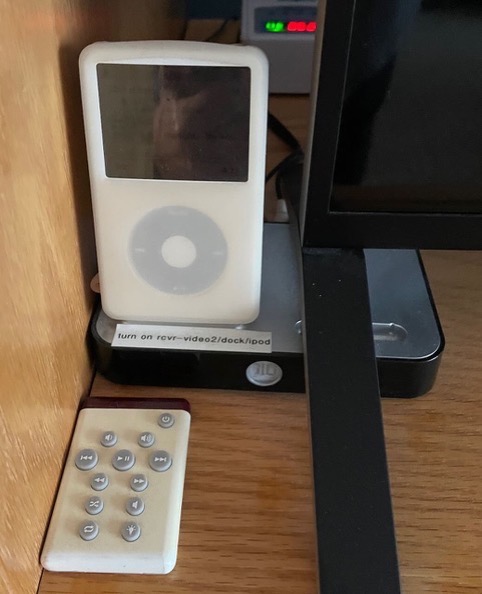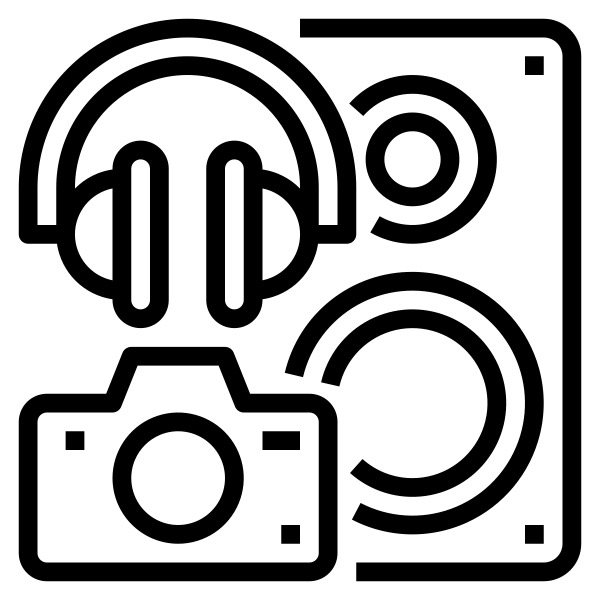In Part 3 of our “I’m Still Using It” series, we’ve got some golden oldies from the lovely NosillaCastaways.
Lynn York on 5th-gen Click-wheel Video iPod

Lynn York has a great I’m Still Using It it for us
Hi Allison,
We are still using a DLO HomeDock that we purchased in 1/2006, with 5th gen click-wheel video iPod from 2005.
It holds a copy of our owned music and serves up over 6K songs when we want music through our Devon receiver and Infinity speakers in the living room.
We have iTunes Match, not Apple Music, so this still works for us. Getting our HomePods to play music from our library has been a frustrating struggle. But that will have to go in dumb question corner sometime. 😉
I look forward to hearing about the other golden oldies that still serve a purpose.
There’s something so joyful about seeing these old iPods still standing, doing their jobs. I’m glad yours continues to provide value to you and Gary and that you get joy from it. This sure brought a smile to my face.
Allister Jenks on Hazel – HE RECORDED THE AUDIO!
In a couple of months, I will have been using Hazel, from NoodleSoft, for TEN YEARS. It has done many different jobs for me over the years, and while those jobs almost always become redundant in time, I always find new ones.
I decided recently to export my entire big boy photo library of over 42,000 images into a folder of lower quality JPEGs, in order to have an easily viewed catalogue should something happen to me and my family be looking through my stuff.
Because I am persnickety about my photos, this is not a straightforward job. I export the photos from PhotoLab, to a fixed location, using a preset. But I want them in year/month folders and I want to also export them from Lightroom and copy the Lightroom keywords to the PhotoLab exports.
Right now, Hazel is churning through the PhotoLab exports, filing them into the right folders, and then when I export the same from Lightroom, Hazel will push those into the same folders and then copy the keywords across before throwing the unneeded Lightroom files in the trash.
Many of my other current rules work on images. The same keyword-copying task occurs for photos I export for Flickr. A couple of special folders that I can export images to will cause Hazel to launch those files into a specific application where such native functionality does not exist, and one folder runs an ImageMagick script on each image.
My Downloads folder is purged of ZIP and DMG files beyond a certain age and also images and documents of a certain age are sent to my Pictures or Documents folders.
I forget many of the other rules I have had in the past, but most will have been along the same lines. Some do often-needed tasks on a few files, others work on masses of files, all of them provide me a level of automation that means I get the job done consistently and reliably.
And that’s Hazel in a nutshell… consistently and reliably making my life easier.
I’ve never looked back to see how long I’ve been using Hazel too, Allister, but I don’t think it’s quite that long. I think I started using it in anger when David Sparks did a video tutorial on how to use it to collect scanned bills, change the titles to match the name of the company and bill due date, and more.
I remember when I did a presentation at the Command-D conference put on by Sal Seghoian and I explained how I have Hazel move my podcast files after they had aged out from my local disk to my NAS.
Two fun things about that, it turned out that the developer of Hazel, Paul Kim, was actually in the audience! He was tickled that I’d showcased it and luckily I didn’t do a botch-up job of explaining what it did.
The second fun thing was that Dave Hamilton was there and when he heard what I was doing with it to clean up podcast files, he slapped his forehead realizing that it was exactly what he needed for his own workflow! It’s not often you get to do something Dave hasn’t thought of so that was a big moment for me.
Just this week Steve asked me what tool he should use to make sure that when he deletes the Drobo Dashboard software that it gets rid of all the cruft. I explained to him that Hazel, which he already uses for scanning in bills, would do it for him. He was quite pleased when he through the main app in the trash and Hazel popped and said, “do you want me to get rid of this pile of plists and other glop too?”
Hazel is one of those tools that sit in the background cleaning up for you and doing the tasks that are tedious and error-prone for humans. If anyone isn’t using it, head over to Noodlesoft.com and give it a whirl.
Thanks so much for this, Allister – it’s the first software “I’m Still Using It” we’ve had!
Claus Wolf on FlightRadar24

There is no denying it, I am a bit of an aviation enthusiast and while the app I am about to introduce is very much targeted at this demographic, it is quite useful for many. I’m still using FlightRadar24, available online at FlightRadar24.com
So what problem does it solve?
Have you ever wondered, “What airplanes are overhead and where they are going?” Open FlightRadar24 and it will let you know that and more.
If you are stuck at an airport and wonder if your delayed plane has even left its previous airport? Type the flight number into FlightRadar24 and click on the live map.
On Thanksgiving Day I was waiting in Antalya for a delayed flight. As I wrote to Alison on Telegram to remind her about a visit to the Hollywood sign seven years ago, I watched my delayed aircraft leave Istanbul. I mean literally, I could see a little aircraft icon move along the runway as they departed and to me, that is really cool!
But how do you know which flight comes before your flight? Quite easy: You search for your flight, e.g. TK2409, then tap “aircraft info”. This will show some useful info about your aircraft: things like the aircraft type, registration, and even a picture. But more importantly for this use case, the other flights the aircraft has recently been on.
FlightRadar24 also offers a lovely “replay” feature, which will let you relive your epic flight to someplace far away and help you identify that landmark, which you couldn’t readily identify. All you have to do is remember the time.
The app/website operates on a freemium model and I enjoy the “business account”, as I have a little Raspberry Pi that serves as one of the nodes providing data to their service.
There are quit a few aircraft enthusiasts in the NosillaCastaway community (especially Allister Jenks) so this is really cool to learn about it, Claus. One of my favorite things about the Internet is that we can now point our phone’s camera at a flower and know it’s proper name, or have our devices listen to a bird and tell us what it is, or even find out what plane is flying overhead.
Kenneth Berger on 30GB iPod Classic
Kenneth Berger brings us the next I’m Still Using It. He says:
We won’t discuss the AirPort Express that I decommissioned a number of years ago, but we will talk about my 30GB iPod “Classic,” which was called a “Video” iPod when it came out.
I bought it around 2007, which was about 2 years after I bought my first Mac. Both of my sons had Mac computers before that, but my 2005 iMac was my first one, after spending about 10 years living with those wonderful Blue Screens of Death on several Windows PCs.
Although I didn’t know what a playlist was, I managed to figure out how to download music to the iPod that I had ripped from an assortment of CDs.
This now brings us to what I call “The Great Podcast Conspiracy.” I had heard of podcasts, but I didn’t really know what they were, and I certainly didn’t know how to put them onto my iPod.
One day, after I completed my daily syncing process, I noticed something that I had never seen before on the iPod. It was something entitled “TWiT: This Week in Tech.”
I didn’t know what it was and how it got there, but I listened to it. It appeared to be some type of panel discussion. I listened to the whole program and didn’t quite know what to make of it.
The following week, another episode appeared, and then I was hooked. My podcast list is now quite extensive. It might have been on TWiT’s “Macbreak Weekly” that I heard about the “Nosillacast,” so I’ve been hooked on that, too.
My first iPhone was the 3GS, which I bought in 2009, so I no longer needed to carry my iPod anymore. Instead of retiring it, I bought a Sony “Dream Machine” stereo clock radio, which has a 30-pin connector, and I set its sleep timer every night at bedtime and fall asleep to music being played by that 15-year-old iPod!
Thanks for the show and have a wonderful holiday season!
Wow – this is the week of “I’m still using this iPod”! I love your conspiracy theory on podcasting. No one has ever caught on that it was an insidious plot hatched by me and Leo. Looks like it worked!
While I don’t listen to music myself, I’m so glad that after 15 years, the iPod Classic is still singing you bedtime lullabies.
Kevin Jones on the Abacus
I didn’t know what to expect when I threw out the idea to the NosillaCastaways but the next entry from Kevin Jones was probably the biggest surprise. I thought the most ancient tech was going to be Bruce on emacs from 35 years ago, but maybe not.
When I was in elementary school, a talking calculator with the four basic functions cost $500, so in fourth grade one of my teachers taught me how to use an abacus. This was huge because math on paper in braille was slow, difficult, and cumbersome.
Several years later Sharp released a basic talking calculator costing $70, affordable to most people including my parents for Christmas when I was in high school. Calculators were not allowed while taking the ACT test so I took in my abacus. The Procter was convinced it was electronic and took 5 minutes trying to find where the batteries were, they finally gave in and let me use it.
More recently, I found I could do math in binary on an abacus, and used it on Cisco networking exams. No subnet calculators are yet allowed on those either.
With several computers around me as I write this, I still have an abacus on my desk. It’s still more efficient for me to grab it and add up a few numbers than to open up a calculator program and leave where I’m currently working.
I know the abacus hasn’t been updated in decades, but it still gets amazing batter—no, still no batteries. When Allison asked for examples of old technology listeners were still using I just couldn’t resist.
Isn’t that crazy? I had no idea that an abacus could still be handy. I’m adding it to my list of “things I want to learn”. Thanks so much for sending this in, Kevin!
Terry of Palo Alto on Brother Daisywheel Printer
Terry of Palo Alto brings us another blast from the past.
As a US Government certified old person, I’m still using some vintage technology. For instance, I’m typing this on a 35-year-old Northgate 102 keyboard that has served about 20 computers along the way. Also, I’m proud to say I still own and maintain my first car, which is a 1972 Datsun, and I play a 1952 electric guitar.
These items are examples of superb engineering lasting over the years and enjoyed by lots of folks today. The car and guitar are now considered vintage and collectible, and at least Steve Gibson and I prefer the old Northgate 102 keyboard.
Now, let me turn to a piece of tech gear that is approaching 40 years old, and is still working on a regular basis. But this time, I’ll argue that it may be the last working example and that I may be the last person on the planet using one. What is it? Let’s start with some clues first.
It was purchased in 1983 as part of my first computer system, an IBM PC with two floppy drives instead of just one. About 20 years ago, it suffered a catastrophic component failure but was fixed by a small piece of wood with a DIY repair. I use it on a monthly basis, and it would be hard to replace it with modern technology.
So what 1980s technology could survive 40 years and still be uniquely useful? Pause
Give up?
Well, it is a Brother HR15 daisywheel printer.
In 1983, I was working at the Stanford Accelerator Center and was the third person to venture out and purchase a “personal” computer. My goal was to support a side-line business, and I needed to write technical proposals. The computer was just to run a word processor, and I got a daisywheel printer instead of a dot matrix so that my proposals would look more formal.
In those days, Brother made traditional typewriters, and the engineers simply made the HR15 by removing the keyboard on the front and installing an LPT port on the back.
All was good writing proposals, but as business needs grew, my attention turned to managing inventory and finances. In those days there was not much commercial software available, outside of Lotus and a few word processors. I heard that there was something called dBase, which had no useful user interface but could be programmed to make your own. So, propelled by my intrinsic laziness, I started automating all the typical business processes like inventory management and financial control. The best part is that I could design my own user interface and get things done with the absolute minimum number of key presses.
It didn’t take long to include printing checks in my chain of laziness. With one screen entry, I could capture the expense, print the check, log it in a searchable database, update account balances, and print out a yearend report for the accountant. Thus began my long relationship with this printer. My dBase programs have evolved over the years, and they still manage all my financial records. The HR15 still prints checks every month.
But sadly, about 20 years ago, it could no longer print. The printer used a hard rubber cylinder as the “hammer” that struck the daisywheel, and over years, it cracked and fell off. There didn’t seem to be any prospect to get replacement parts, so I just gambled and made an identical shape out of an oak dowel. I installed the oak striker, and it has been working fine ever since.
And so is the story of the venerable Brother HR15, still pounding on after all these years.
This is epic, Terry. I found the DaisyWheel Printer in the Computer History Museum! I loved the part of the story where you made a replacement part with an oak dowel. That’s simply awesome. You also solved a mystery for me. Remember what I said about learning vi in response to Bruce and emacs? I said that I used a device that was kind of a cross between a computer and a typewriter. I do remember it had a flat, plastic typewriter print wheel that you could change out. It was a DAISYWHEEL printer! I’m so happy that you solved this for me. Now if I could just remember what was driving the printer at the time…

